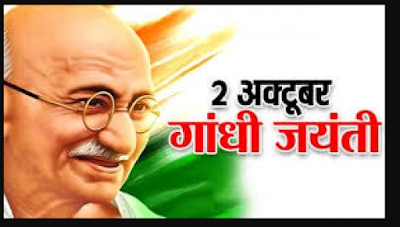2 OCTOBER GANDHI JAYANTI:
2 OCTOBER GANDHI JAYANTI
In Indian festivals, Gandhi Jayanti- 2 October is also considered an
important festival. It is celebrated in the pious remembrance of Father of the
Nation Mahatma Gandhi on 2 October. From the point of view of Mahatma Gandhi's
ambition, we can say that October 2: Gandhi Jayanti has not only national
importance but also social and cultural importance.
How 2 October Gandhi Jayanti is celebrated: -
In India, What is the reason for celebrating Gandhi Jayanti as a
national festival? When we consider it. So we get the answer very
easily. That is, Mahatma Gandhi was such a great man of our country, who
put his full benevolence in charity. He
was such a divine figure who provided the weapon of truth and non-violence to
break the shackles of subordination. Wrote the immense power and influence
of the British Empire with this immovable weapon, wrote a new chapter in world
history. The whole world accepted this wonderful weapon of his pleasure. World
made him not only a miraculous man, but an avatar. He is seen and
experienced with great respect as a great man.
It can be
accepted with a very simple sense that the great need and utility of Mahatma
Gandhi during the struggle for independence was not less in today's era. In
this context, it would be appropriate to say that if Mahatma Gandhi had been
there today, he would have given the aim and the age-old truth and non-violence
to any other astounding weapon. On this basis, we can say that even today
Mahatma Gandhi's relevance remains. The same will not remain in the
future. This is because even today, there are some problems, national and
international, which cannot be solved by weapons, but only by some expected
weapons like truth and non-violence.
Gandhi Jayanti (2 October) is celebrated in many innovative ways by
students and teachers of schools and colleges, government officials, etc.
across India. It is celebrated at Raj Ghat, New Delhi by offering flowers to
the statues of Mahatma Gandhi. Offering the honor, people sing their favorite
devotional song "Raghupati Raghav Raja Ram" and other traditional
activities are performed by government officials. Raj Ghat is the cremation
ground of Bapu, decorated with garlands and flowers. Tributes are paid to this
great leader by offering bouquets and flowers at the tomb. At the Mausoleum,
religious prayers are also held in the morning.
On these day Schools, colleges, government offices, post offices, banks,
etc. are closed on Gandhi Jayanti to pay homage to the national leader of
India. We celebrate this day to remember Bapu and his great works. Students are
allocated on this day to do various tasks such as poetry or speech recitation,
essay writing, drama, slogan writing, group discussion, etc. based on the life
and works of Mahatma Gandhi.
Gandhi Jayanti 2 October in Capital Delhi: -
Gandhi Jayanti is celebrated in the unique form on 2 October in capital Delhi.
On this day, in the morning Mahatma Gandhi's Samadhi offers flowers to one
great person at Rajghat and pays their tribute to him.
In our India The Prime Minister, President, Ex-Prime Minister,
distinguished politicians of the country including many social workers and
patriotic Gandhi Samadhi visit the Rajghat and pay a wooly tribute with a
wreath. There is also a prayer meeting in reverence for Mahatma Gandhi. Loved
hymn of Mahatma Gandhi ji over there:
Singing the song of -
“Raghupati
Raghav raja raam.
patit
pavan sita ram ..
ishwar
allah tero naam.
sabako
sunaamee de bhagavaan ”
Gandhi Jayanti October 2 Various programs: -
Gandhi Jayanti is organized on 2 October in different parts of the
country in India. Various types of celebration meetings etc. are held
related to the life of Mahatma Gandhi. Based on the life of Mahatma Gandhi
and his life related drama, music, dance, playing, Demonstrations and
tableaux are presented. Bapu's lifeline is underlined in many ways in
schools and colleges and educational institutions. Children meetings take
place. Competitions are held. These encourage the students with
special types of awards to make their lives inspiring. Some Gandhians are
such educational institutions. Where the main things and aspects of
Gandhi's life are presented in a very interesting and effective manner on
Gandhi Jayanti day i.e. October 2. These institutions also organize
lecture garlands highlighting the life of Bapu. These institutions also
honor and reward the experts and scholars of Gandhi life.
Indian Popular public institutions like educational institutions and
government establishments also organize banana, exhibition, competition and
seminar in place to celebrate Gandhi Jayanti on 2 October with great devotion. She
reveals her pious feelings towards Gandhiji’s and takes a firm determination to
follow the path shown by him. Thus, on Gandhi Jayanti, the entire
atmosphere is filled with gaiety and enthusiasm. Child-aged people all
appear happy. Public places are more visible.
Gandhi Jayanti 2 October Holiday Day: -
On Gandhi Jayanti 2
October, all government and social establishments are on holiday, Gandhi
Jayanti is celebrated with great fanfare across the country as a great
celebration. The Gandhian people who are influenced by the Gandhi Darshan, mark
the Gandhi Jayanti on October 2. Prepare cloth by spinning wheel. We remember
Mahatma Gandhi with great devotion and reverence. They take the determination
to follow their ideas and principles.
About Mohandas Gandhi(Mahatma Gandhi):
Mahatma(Mohandas karamchand) Gandhi was born in a small
coastal town, Porbandar, Gujarat. He did all the great things through his
life which still have an impact on people in this modern era. She has
worked with efforts to achieve Swaraj, removing untouchability customs from
society, eradicating other social evils, empowering women's rights, developing
the economic status of farmers and many more. He launched three movements
in the Non-Cooperation Movement in 1920, the Dandi March or Salt Satyagraha in
1930 and the Quit India Movement in 1942 to help the people of India gain
independence from British rule. His Quit India movement was a call of the
British to leave India.
Civil disobedience was one of the reasons that led to India's
independence. Civil disobedience is the true meaning of a decline in civil law,
especially as a disagreement for certain demands. Mahatma Gandhi used
civil disobedience as a non-violent way to protest against British rule. He
initiated several harsh defiance movements during British rule and opposed many
harsh acts and policies of the British government.
Through the Champaran Satyagraha
of 1916, Mahatma Gandhi opposed the tax (rent) imposed on the peasants by the
British during the subversive scattering with peasants and servants. In 1916,
Mahatma Gandhi was imprisoned in Champaran district of Bihar, India for
organizing civil protection of thousands of landless peasants and servants With
his determination, Gandhi jolted the British in 1930 with 440 km of hiking in
the sea. It was originally meant to fight the British salt monopoly and
lead the Indians to disregard the British forced salt tax. The Dandi Salt
March has been kept in history, where about 60,000 people have imprisoned the
result of the protest march.
However, the story of India and the extent of India's struggle
for freedom were very long and many people sacrificed their lives during this
process. Eventually, India achieved independence in August 1947. But
with independence, there was a terrible division. After the independence
of India in 1947, after partition and religious violence on the liberation of
India and Pakistan, Gandhi began numerous fasts to end religious violence. Bapu
was killed on January 30, 1948 (Mahatma Gandhi's death date) after being shot
by Nathuram Godse at Birla House in New Delhi.
What did Mahatma Gandhi try
to do with his activism?
Initially, Mahatma Gandhi's
campaigns sought to counter the second-tier Indians gained by British rule. Eventually,
however, he turned his attention solely to advancing British rule, a goal that
was achieved in the years directly following World War II. This victory
came from the fact that the communal violence within India between Hindus and
Muslims necessitated the creation of two independent states — India and
Pakistan — as opposed to a unified India.
What were Mahatma Gandhi’s religious beliefs?
Mahatma Gandhi's family practiced Vaishnavism, one of the
predominant traditions within Hinduism, divided through morally rigid
principles of Jainism - an Indian belief for which concepts such as austerity
and non-violence are important. Later in life, many beliefs that
characterized Gandhi's spiritual outlook arose in his upbringing. However,
his understanding of faith was constantly evolving as he faced new belief
systems. Leo Tolstoy's analysis of Christian theology, for instance,
overshadowed Gandhi's concept of spirituality, as in texts such as the Bible
and the Qur'an, and he first read the Bhagavad-Gita - a Hindu epic - that lived
in Britain Hué was in his English translation. .
What other social movements
inspired Mahatma Gandhi's activism?
Within India, Mahatma Gandhi's philosophies were based on the
messages of reformers like philanthropist Vinoba Bhave. Activists such as
Abroad, Martin Luther King, Jr. borrowed heavily from Gandhi's practice of
non-violence and civil disobedience to achieve their own goals of social
equality. Perhaps most effectively, the independence that Gandhi's
movement achieved for India sounded the death knell for Britain's other
colonial enterprises in Asia and Africa. The freedom movement swept away
like wildfire with Gandhi's influence promoting existing movements and igniting
new ones.
How was Mahatma Gandhi's
personal life?
Mahatma Gandhi's father was a local government official
working under the British Raj, and his mother was a religious devotee who -
like the rest of the family - prevailed in the Vaishnavist tradition of
Hinduism. Gandhi married his wife, Kasturba, when she was 13, and together
they had five children. His family lived in India, while Gandhi went to
London in 1888 to study law and in 1893 to South Africa to practice it. He
brought her to South Africa in 1897, where Kasturba assisted her in her
activism, which she continued to do after the family moved back to India in
1915.
What were the contemporary
thoughts of Mahatma Gandhi?
Appreciating Mahatma Gandhi as a figure, his actions and
beliefs did not escape criticism from his contemporaries. Liberal
politicians thought he was proposing a change too quickly, while young radicals
scold him for not offering enough. Muslim leaders suspected their lack of
harmony when dealing with Muslims and their own Hindu religious community and
Dalits (formerly called untouchables) and thought of their apparent intention
to end the caste system. He also cut a controversial figure outside India,
though for various reasons. The colonists of India, as English, expressed
some resentment towards them, as they had defeated one of the first dominoes in
their global imperial rule.








👍👍👍
ReplyDeletethanks
DeleteWow such a well researched article. You mentioned correctly many problems are still existing and they will not go away with violence. Non violence is the only way out.
ReplyDeleteTysm😊
DeleteI liked the way you highlighted everything, even the personal life of Bapuji. It seems you have done loads of work.
ReplyDeleteThank a lottttt
Delete